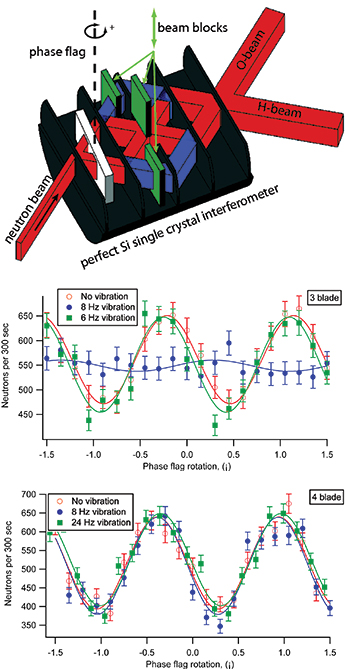Summary
We have designed a new type of neutron interferometer that will be less sensitive to slow vibrations. The design improves the interferometer sensitivity and also makes it easier to adopt the technique at other neutron facilities.
Description

Single crystal neutron interferometers are extremely sensitive to environmental noise, including vibrations. This sensitivity is a result of slow neutron velocity and the long measurement times. Most neutron interferometers require vibration isolation. Usually, massive systems are employed to damp vibrations less than 10 Hz. We have designed a new type of neutron interferometer which will be less sensitive to low frequency vibrations. Not only will this design improve the interferometer contrast, but it will also make it easier to adopt the technique to other neutron facilities.
We made a proof-of-concept five blade single crystal interferometer that incorporates both the Mach-Zehnder (MZ) and Decoherence-Free (DF) geometries in one single perfect silicon crystal. By removing or adding neutron absorbing cadmium beam blocks, we can choose either the MZ or DF equivalent (see Figure 1). This allows us to compare the MZ and DF under the same conditions.
Calculations show that the DF configuration is much less sensitive to low frequency vibrations. For the DF configuration the contrast does eventually fall off at high frequencies, which can be easily damped with small, commercially available systems. The decrease in sensitivity to vibrations in the DF case is due to the fact that any change in momentum caused by vibrating blades in the first loop is compensated by the same change in the second loop. In the MZ case this is not true. Figure 1 shows interferograms for the two cases. For the MZ case, the fringe visibility becomes zero at only 8 Hz while at the same frequency the DF still has optimal visibility.
These results demonstrated a concrete example of how quantum information theory can control the effects of noise on useful macroscopic quantum devices. They validated our expectations that a quantum code can improve coherent control in neutron interferometry. The DF interferometer's insensitivity to vibration enables it to be placed closer to the neutron source, thereby recovering neutron intensity by having a larger solid angle reach the detector. We anticipate relying on this and other related quantum information theory approaches to construct a new series of compact neutron interferometer setups tailored to specific applications.
Partnering with the University of Waterloo we have developed, to unprecedented precision and uniformity, new techniques in the fabrication of silicon. We have successfully improved two perfect crystal interferometers to near theoretically maximum performance. The fabrication of a large 4-blade interferometer is now possible. Our results in improving silicon fabrication can be found at “Achieving a near-ideal silicon crystal neutron interferometer using submicrometer fabrication techniques” in Physical Review Research 6, 043079 (2024) and “Increased interference fringe visibility from the post-fabrication heat treatment of a perfect crystal silicon neutron interferometer” in Review of Scientific Instruments 8, 023502 (2018).

